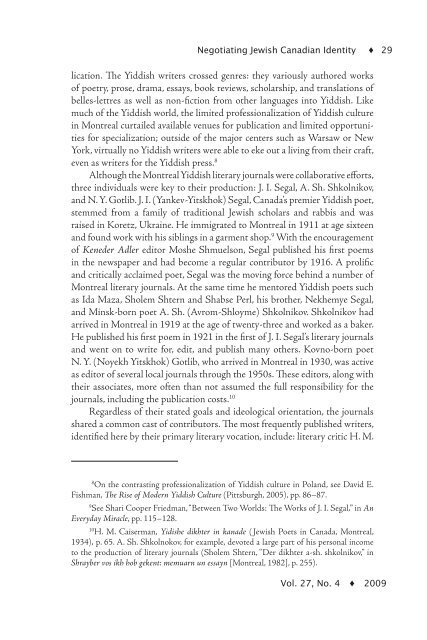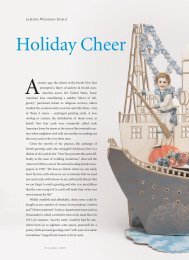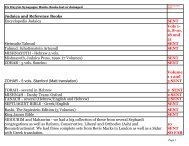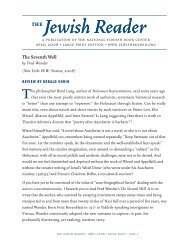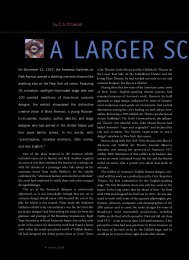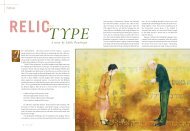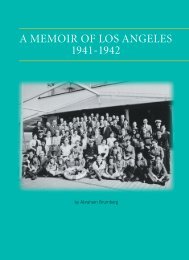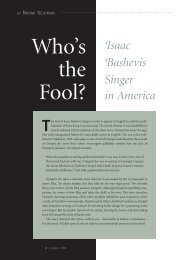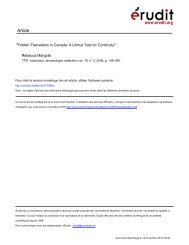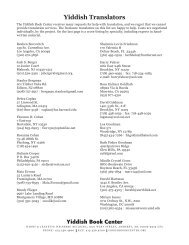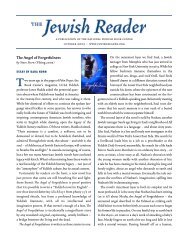Negotiating Jewish Canadian Identity Montreal Yiddish Literary ...
Negotiating Jewish Canadian Identity Montreal Yiddish Literary ...
Negotiating Jewish Canadian Identity Montreal Yiddish Literary ...
You also want an ePaper? Increase the reach of your titles
YUMPU automatically turns print PDFs into web optimized ePapers that Google loves.
<strong>Negotiating</strong> <strong>Jewish</strong> <strong>Canadian</strong> <strong>Identity</strong> ♦ 29lication. The <strong>Yiddish</strong> writers crossed genres: they variously authored worksof poetry, prose, drama, essays, book reviews, scholarship, and translations ofbelles-lettres as well as non-fiction from other languages into <strong>Yiddish</strong>. Likemuch of the <strong>Yiddish</strong> world, the limited professionalization of <strong>Yiddish</strong> culturein <strong>Montreal</strong> curtailed available venues for publication and limited opportunitiesfor specialization; outside of the major centers such as Warsaw or NewYork, virtually no <strong>Yiddish</strong> writers were able to eke out a living from their craft,even as writers for the <strong>Yiddish</strong> press. 8Although the <strong>Montreal</strong> <strong>Yiddish</strong> literary journals were collaborative efforts,three individuals were key to their production: J. I. Segal, A. Sh. Shkolnikov,and N. Y. Gotlib. J. I. (Yankev-Yitskhok) Segal, Canada’s premier <strong>Yiddish</strong> poet,stemmed from a family of traditional <strong>Jewish</strong> scholars and rabbis and wasraised in Koretz, Ukraine. He immigrated to <strong>Montreal</strong> in 1911 at age sixteenand found work with his siblings in a garment shop. 9 With the encouragementof Keneder Adler editor Moshe Shmuelson, Segal published his first poemsin the newspaper and had become a regular contributor by 1916. A prolificand critically acclaimed poet, Segal was the moving force behind a number of<strong>Montreal</strong> literary journals. At the same time he mentored <strong>Yiddish</strong> poets suchas Ida Maza, Sholem Shtern and Shabse Perl, his brother, Nekhemye Segal,and Minsk-born poet A. Sh. (Avrom-Shloyme) Shkolnikov. Shkolnikov hadarrived in <strong>Montreal</strong> in 1919 at the age of twenty-three and worked as a baker.He published his first poem in 1921 in the first of J. I. Segal’s literary journalsand went on to write for, edit, and publish many others. Kovno-born poetN. Y. (Noyekh Yitskhok) Gotlib, who arrived in <strong>Montreal</strong> in 1930, was activeas editor of several local journals through the 1950s. These editors, along withtheir associates, more often than not assumed the full responsibility for thejournals, including the publication costs. 10Regardless of their stated goals and ideological orientation, the journalsshared a common cast of contributors. The most frequently published writers,identified here by their primary literary vocation, include: literary critic H. M.8On the contrasting professionalization of <strong>Yiddish</strong> culture in Poland, see David E.Fishman, The Rise of Modern <strong>Yiddish</strong> Culture (Pittsburgh, 2005), pp. 86–87.9See Shari Cooper Friedman, “Between Two Worlds: The Works of J. I. Segal,” in AnEveryday Miracle, pp. 115–128.10H. M. Caiserman, Yidishe dikhter in kanade ( <strong>Jewish</strong> Poets in Canada, <strong>Montreal</strong>,1934), p. 65. A. Sh. Shkolnokov, for example, devoted a large part of his personal incometo the production of literary journals (Sholem Shtern, “Der dikhter a-sh. shkolnikov,” inShrayber vos ikh hob gekent: memuarn un essayn [<strong>Montreal</strong>, 1982], p. 255).Vol. 27, No. 4 ♦ 2009


